Any respectable commercial street has gone through some cycles of renovation and rejuvenation. In the decades after World War II, that often meant putting a new facade on your building – sometimes tearing off the old completely, but sometimes taking a cheaper route and just hanging something new right on top of the old, an approach known as the slipcover.
West Madison is no exception; some of its seemingly unremarkable storefronts have quite a bit of history behind them.
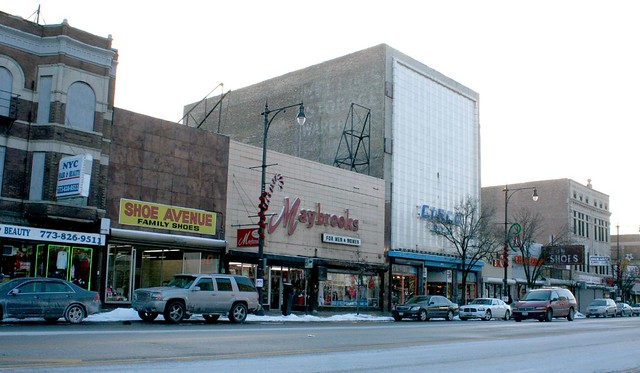
4019 W. Madison Street (Shoe Avenue): Two upper floors hide behind that checkered brown granite facade. A parade of businesses has occupied the building, sometimes more than one at once. Articles from 1941 and 1987 both mention people listing it as their residential address, as well. Businesses I could find, and dates they were definitely there, include:
- A. Rost and Son shoe store, 1917-1920
- Wormser Hat Store, 1930-1940
- York Women’s Apparel, 1943
- Jerome Millenery Store, 1948-1962 – the building was renovated by architects Lowenberg & Lowenberg in anticipation of this store’s opening, giving it its current Modernist facade. The upper floors used for making women’s accessories by hand, seemingly run as a separate business, the Una Harvey Shops. Lowenberg & Lowenberg was a prolific architectural firm whose successor is still in business today; the company also worked on the iconic University Apartments in Hyde Park, several sumptuous high rise apartment buildings, the Colony Theater on 59th Street, and a similarly radical recladding job on a building right near my old home in Rogers Park.
- Two Legs Inc. – 1953
- Today: Shoe Avenue Family Shoes.
4021 W. Madison Street (Maybrooks) – a two story building, either built or re-built in 1951. A one-story garage and store – visible in the postcard below – stood on the site originally.
- Keen and Howe clothing store – 1915
- E. Newman Paint Company – 1924
- A. Rost & Son – 1927 (moved from next door!)
- Father & Son shoe store – 1942-45
- Lynn Niles Shoes – 1946-1950
- Bond Clothing Store – opened Nov 30, 1951; operated at least through 1968. Their opening seemingly triggered the replacement of the original structure with the present one.
- Maybrooks – For Men and Women – 1986-2011
- Present: YOLO Ladies Ware & Shoes, since ca. 2012
4027 Madison Street (aka 4025-29 W. Madison) – James Burns, architect; Henry Ericsson Co., general contractor
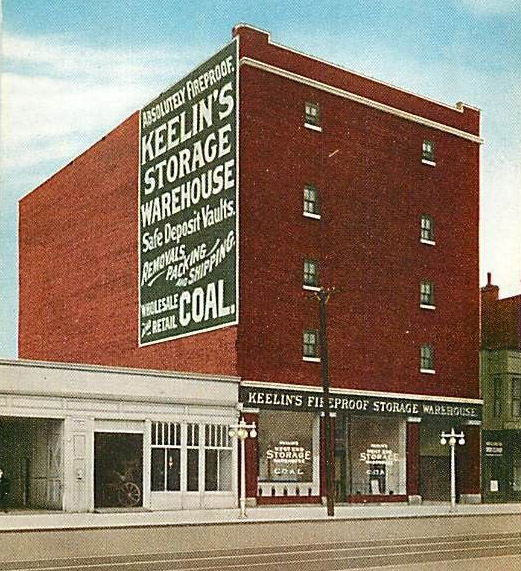
Postcard view – compare with the previous photo
Towering above the 1- and 2-story stores around it, this blank-walled hulk was designed in 1910 and built by 1911, for the Keelin Fireproof Warehouse Company. On the east party wall, a faded ghost sign still announces the original occupant with a barely-legible “Keelin’s Storage Warehouse”. Fireproof storage warehouses are a whole genre of buildings in Chicago (and the topic of a future post). Like most, this one – also known as the West End Storage Warehouse and the Keelin Brothers Warehouse – was built of reinforced concrete, with steel doors and minimal windows (illuminating only the corridors), and a facade of pressed brick. It’s among the simpler of its kind, with its already minimal ornament now lost to age and a mid-century rehab that covered the facade with a grid of square tiles.
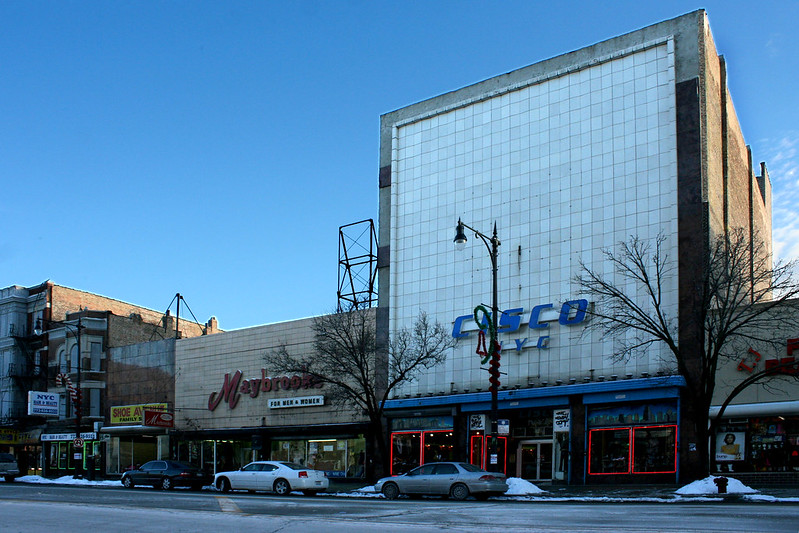
The Keelin brothers were a prominent business family with their hands in coal and grain interests. Two of the brothers were indicted on conspiracy and fraud charges in 1921. Architect James Burns (ca. 1858-1933) was a Chicago practitioner, active from the 1890s into the 1920s, and the designer of various houses, flats, stores, factories, and most prominently, several significant Catholic churches: St. Columbanus on E. 71st, St. Gertrude’s in Rogers Park (Burns’ neighborhood), and St. Keven at Torrence and 105th.
In 1912, the address made small-headline news when a 14 year old boy died in the building while trying to exit its elevator.
Gold Point Hosiery Stores leased the ground floor in 1928 and converted it into a retail storefront; they remained there at least through 1930. In 1947, the building was sold, and O’Conner and Goldberg leased the entire building, opening a new store at the location which lasted from 1949 into the 1960s. This major turnover was likely the point at which it gained its new Mid-Century facade of square panels.
In recent years, the storefront has been home to Cisco NYC, a high-end clothing and shoe store specializing in hip hop culture. Cisco NYC got some unwanted attention in late 2014 when it became the latest victim of a string of smash-and-grab robberies happening all around the city. A gang of thieves used a mini-van to smash through the store’s gated front entrance at 4am on a November night; 20 masked robbers poured into the store, stripped it of thousands of dollars worth of a single brand of designer jeans, and escaped within three minutes. Despite the devastating loss, the store was soon open again and joined in a local Madison Street tradition of opening on Christmas Day.
3932 W. Madison (Catholic Charities)
Appears to have been built in the 1920s. Today it’s covered in polished granite panels, a massive frame surrounding 2 stories of windows with a sheltered balcony, and accented with a two-part stainless steel sign. 65 years after the new facade was added on, it still looks terrific.
- 1925-1930 – Apex Stores (refrigerator dealers)
- 1936-1963 – Apollo Savings and Loan, who remodeled the building into its current form. Grand re-opening for the renovated structure was November 16, 1950. Apollo moved downtown in 1963, before imploding in 1968. They sold the building in 1967.
- 1967 – Headquarters and later Credit Union of the Christian Action Ministry
- Today – The Catholic Charities of the Archdiocese of Chicago / WIC Food Centers
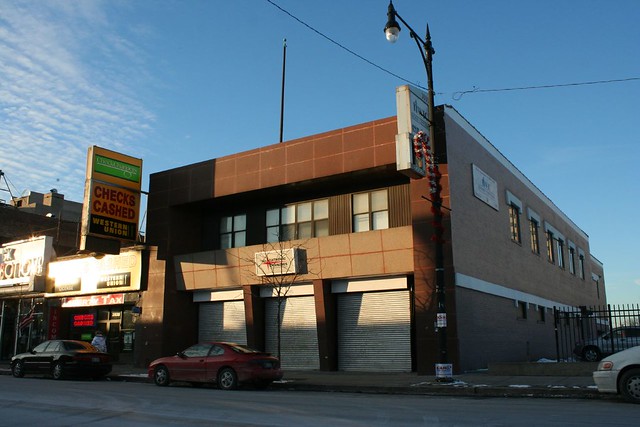
4126 W. Madison Street (Green Star Groceries)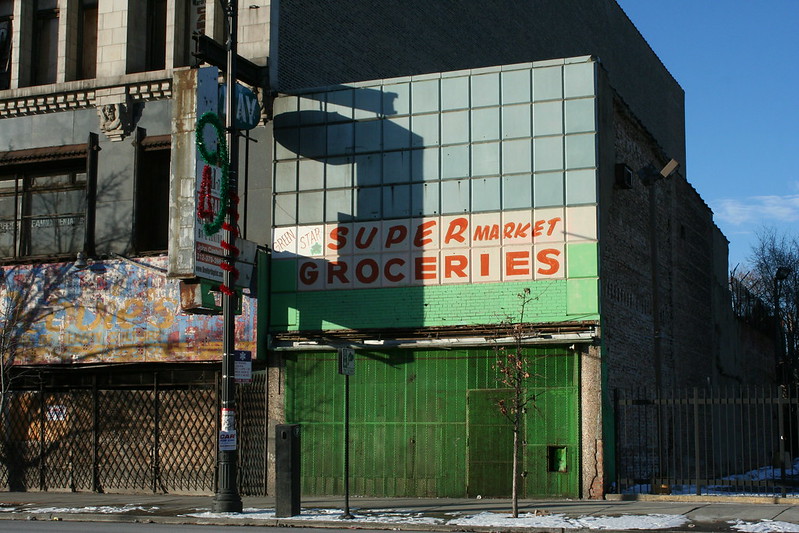
This sad little two-story building was built around 1927. It’s barely visible in its original form in the background of this photo of the Marbro Theatre, which stood next door until its 1964 demolition. With its pale green color, the slipcover screams early 1960s.
- 1926 – Fignter(?) Scott Co. (furniture finishing? hardware?)
- 1930 – Western Radio & Electric Stores
- 1932-34 – Lee Radio Stores / Lee’s Radio Shop / Lee’s Radio & Refrigerator Store
- 1935 – Straus & Schram (Lee’s had moved a few doors away. Or it’s a typo.)
- 1938-42 – Singer Sewing Company
- 1956-63 – Little Dutch Mill Candies
- Most recently – Green Star Super Market Groceries
Due to a text resolution issue (4126 looks a lot like 4128 to an OCR scanner), this address is almost entirely overshadowed in the Tribune archives by the Spiegel store that operated next door.
4034 W. Madison – City Sports Shoes & Sportswear
Sometimes slipcovers are just a flagrantly bad idea – they make a building look worse to begin with, and that’s before they start falling apart and exposing bits of the vastly superior facade they hide. Such is the case here, where column capitals and ornate shield emblems in colored terra cotta have forced their way out from beneath a plain grid of rectangles, painted over in white.
- 1934-36 – Grossman’s shoe store
- Burt’s shoe store – Burts – then a subsidary of Edison Brothers Stores – opened an outlet at this location in 1937 with a $25,000 “modernization program”, which seems too early to have been the date of the slipcover. In 1956 the chain changed its name to Bakers, in keeping with their shoe line in other cities, and continued on here through 1962.
- 1971 – Mary Jane Shoes
- 1977 – A.S. Beck Shoes
- Today – City Sports Shoes
And finally, a note about some of the trends I’ve seen in researching these places. First is turnover – many stores only last a few years before vanishing. Some of it is just the economy – it’s almost guaranteed a small store present in 1929 will be gone by 1932, wiped out by the Depression. Similarly, many stores had good long runs from the late 40s into the 1960s or early 70s, boom years for the city. Even then, many beloved retail institutions were really only around for a couple of decades.
Second is consistency – if a storefront started off as a shoe store, it was very likely to stay a shoe store, even as ownership and names changed repeatedly. Clothing stores stayed clothing stores – Cisco NYC, for example, is continuing an almost 90 year tradition of clothing sales in that space.
Third is the abruptness with which a business can vanish. A tempting assumption is that the advertising budget was the first thing to go when times went sour. Many places ran weekly display ads for years – until suddenly they’re just gone from the Tribune, no going out of business notice, no clearance sales, no nothing. Just – poof! Gone!
Research log for Keelin’s Storage Warehouse:
- 1910 – The American Contractor, September 10 1910 p. 30 col. 1 – notice of drawings on file and bids being taken
- 1912 – Tribune article, Sept. 20
- Assessor: 1914; CityNews: 1947
- Appears in “The Transfer and Storage Directory” of 1916.
- Sold: April 13 1947 article (erroniously gives date of construction as 1900)
- Gold Point Hosiery Stores – leased Feb 1928 (real estate transaction article); display ad April 9 1928 (4027), through 1930
- O’Conner and Goldberg – short article Sep 1 ,1949; display ads through 1966
- 4126: Cook County Assessor puts the date at 1932; CityNews Chicago says 1927; Realtor.com says 1926.
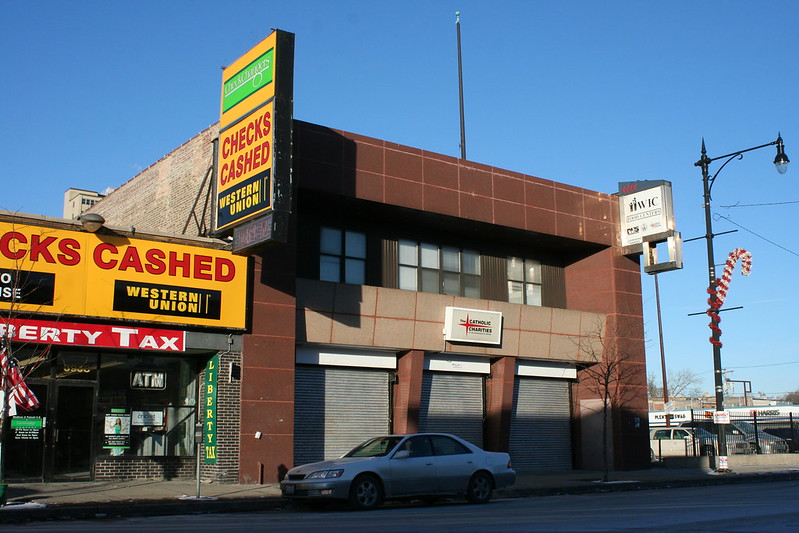
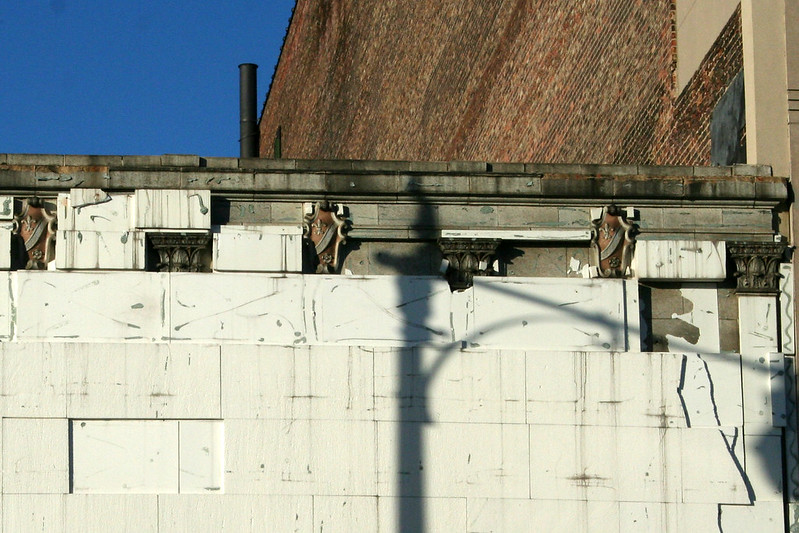
Pingback: Design News / Madison Street West, Part 3: Slip Coverin’ Away
A majority of the dates in this article are incorrect. I lived in this neighborhood and shopped at the stores on Madison Street from 1962 – 1994.
Gloria – you might have missed the (very tiny and short!) note early on that these are the confirmed dates – ie Lee’s Radio Store may have been there before 1932, and it might have been there after 1934, but those are the earliest and latest dates I could confirm.
Otherwise, every date given is reliably sourced. Which ones do you believe are incorrect? I would love to hear & learn more about your time in the neighborhood!
The one that stands out for me is Maybrooks at 4021 W Madison. Maybrooks opened prior to 1986. It was there when I graduated grade school and that was in 1964. Maybrooks closed it’s doors shortly after the 1968 riots on Madison St. I did not take the time to read the article again, but this one just stood out for me because my mother shopped there. They had fine Italian knits for men and women. Also, expensive tailored suits.
Interesting! So they had a good long run. I photographed the store in 2009, and Google Streetview shows it up until around 2011. I don’t know anything about the store – sometimes I delve into the history of chains, but they tend to be so long, complicated and convoluted that I often skip it, especially if I’m looking at a whole set of buildings.
You’ve gotten me curious now. Could Maybrooks have been somewhere else prior to 1968? If closed in ’68, they might have reopened at 4021 later on. I’ll take a look through the archives tonight, see what I can find. It would not be the first time a store shuffled around from storefront to storefront within the same commercial district.
Okay, here’s what I found:
Maybrooks was originally at 4135 W. Madison, about a block west of these buildings. The location had been Komiss Vogue for about 20 years, but they moved out to Irving Park Road around 1962-1963. So Maybrook’s presumably moved in at that point.
An article on the 1968 riots says that the Maybrook’s store at 4135 W. Madison was destroyed by arson on April 5th of that year. It made news because a boy was found shot to death in the store. The site is just a nondescript church building today.
Meanwhile, I found a still-earlier reference to the 4021 location, from 1977. At a guess, Maybrook’s moved into this location after the riots.
Incidentally, there was a Maybrooks Mens Wear at 2358 W. Madison, at Western, from at least 1944 until at least 1966. The building is gone and there’s a Walgreens on the site now. From the news stories I saw, it looks like it too may have been destroyed in the ’68 riots.
I can tell you what I know for sure…we will probably never resolve this issue but I can tell you that Maybrooks was in the 4000 block on Madison St when I was in grade school. I graduated from Tilton Elementary on Maypole and West End in 1964. The store went away after the riots. How long after the riots…..I don’t know. I lived on Jackson and Pulaski and I used to walk to school down Madison Street everyday. The articles you’re using for research have incorrect dates. The Maybrooks store I’m speaking of carried quality upscale men’s and women’s clothing….more men’s clothing than women’s. If I walked down Madison right now I could probably name all of the stores that used to be there……I used to eat lunch at the pizza counter every day at Neisner’s 5 &10 on the NW Corner of Madison and Karlov from 1962 to 1964 where the McDonalds currently resides. Directly across the street on the SW corner there was a Woolworth (also had a counter for eating). There was a Walgreens with a sit down restaurant on the NW corner of Madison and Pulaski and a Goldblatts on the SW corner of Madison which now houses a multitude of stores and a bargain basement of sorts. There used to be a Madigans clothing store next door to the L. Fish Furniture store and near the Bakers shoe store. There was a Three Sisters women’s clothing store on the NE corner of Madison and Pulaski and The Cotton Shop (Women’s Clothing) was on the SW corner where the Church’s Chicken now stands. There was a Fredericks Salon Shoe Store a couple of doors east of the Maybrooks store. This store sold only women’s shoes and handbags….expensive and one of a kind. This shopping area used to be “the place to go”. There also used to be a movie theater on Madison just west of Karlov…..The Marlboro Theater. There was also “The Alex” movie theater in the 3800 block on Madison and the Cascade bowling alley was across the street. I could go on and on because I lived in the area from approx 1960 until 1994.
Do you remember schaumburg’s clothing
It certainly looked better the first time around. Thanks for putting in so much effort in researching it. It is hard to get every detail right but A+ plus for the effort.
Be aware that Google Street View is not a good reference for dating the content of their panoramic photos. They are not updated very often. Unless you have a way of accessing the metadata, they can be years out of date.
I shopped this area when I was in high school in the 1960s and you could always find something nice. Just today, I was wondering where you could buy women’s 100% leather shoes (with leather soles) today. In the 1960’s, you could get them at A.S. Beck and some of the other shoe stores in this area. They were made in Italy and at that time, a pair of all leather loafers or tie-ups cost $25.00 because they were all leather. They don’t make ’em like they used to.
I just found your blog while researching photos in my family’s collection. I am attempting to identify as man as possible and then archive them properly. In the collection are two photos of workers posing at construction sites in Chicago. My guess is that at least a couple of them are relatives, recently immigrated from Northern Ireland ca 1920. One of the buildings has a sign that says: James Burns, Architect, and lists his address and phone number. The question now is where this building was being erected and who the contractor might have been. I have another similar photo, but it does not appear to be the same building in progress and the men are posing but clearly in the midst of doing their jobs. The only identfication is the commercial photographer’s stamp on the back of the photo: Ed. Stratton, 950 W. Monroe St. Any thought on where to go from here for further research? I appreciate how you list all your sources, BTW!